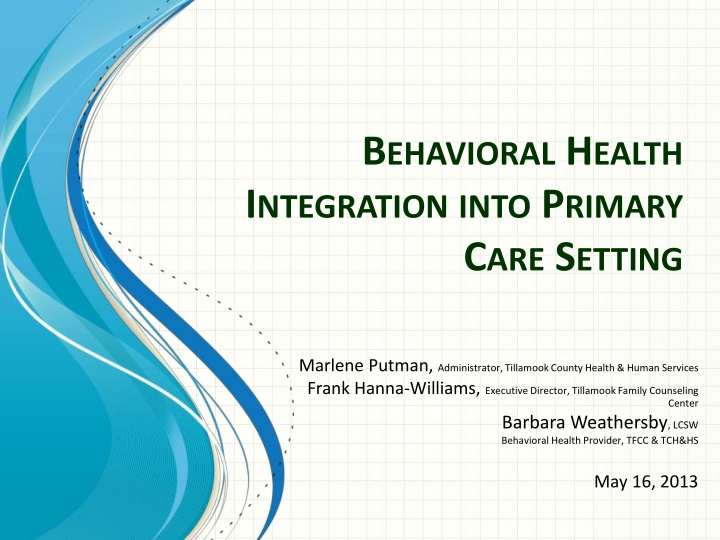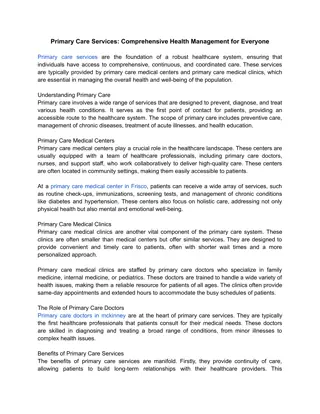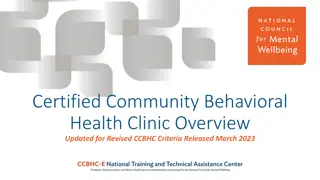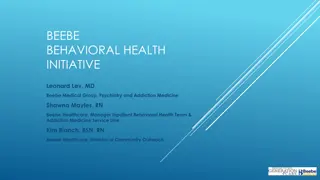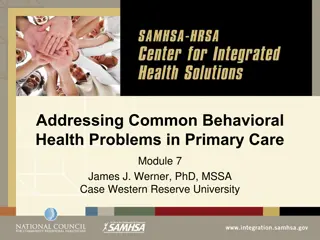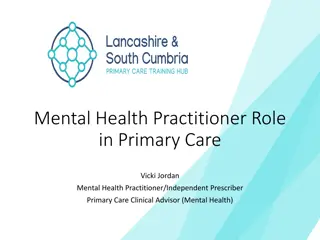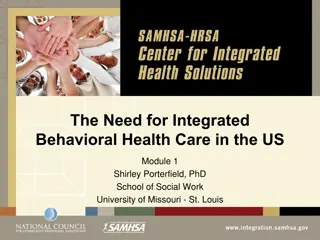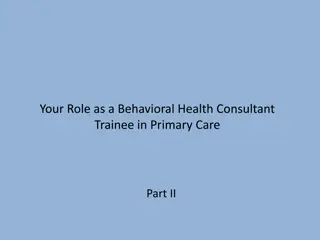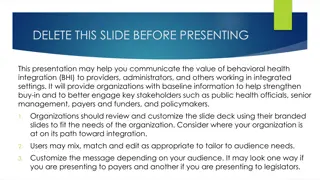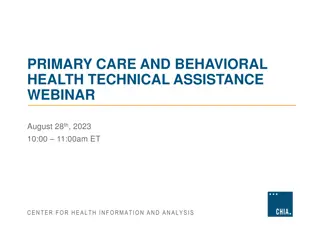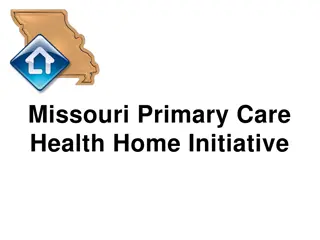Behavioral Health Integration into Primary Care Setting - Tillamook County Integration Project Overview
This presentation outlines the journey of integrating behavioral health into primary care settings, focusing on the Tillamook County Integration Project. It covers the process, partnerships, funding, readiness assessment, on-the-ground implementation, patient-centered medical home care team principles, and team structure. The project emphasizes collaboration between behavioral health providers and primary care teams to enhance patient care.
Uploaded on Sep 21, 2024 | 3 Views
Download Presentation

Please find below an Image/Link to download the presentation.
The content on the website is provided AS IS for your information and personal use only. It may not be sold, licensed, or shared on other websites without obtaining consent from the author.If you encounter any issues during the download, it is possible that the publisher has removed the file from their server.
You are allowed to download the files provided on this website for personal or commercial use, subject to the condition that they are used lawfully. All files are the property of their respective owners.
The content on the website is provided AS IS for your information and personal use only. It may not be sold, licensed, or shared on other websites without obtaining consent from the author.
E N D
Presentation Transcript
BEHAVIORAL HEALTH INTEGRATION INTO PRIMARY CARE SETTING Marlene Putman, Administrator, Tillamook County Health & Human Services Frank Hanna-Williams, Executive Director, Tillamook Family Counseling Center Barbara Weathersby, LCSW Behavioral Health Provider, TFCC & TCH&HS May 16, 2013
Welcome & Introduction Overview What is Integration? Workshop participants Agenda
Tillamook County Integration Project: OUR JOURNEY When & How we started Our Process Our Partnership and Funding Work Underway
The Journey Making It Work!! Partnerships & Funding Integration Efforts Now What?!! Our Process Great Idea!! How we started Time Spent
Readiness Exercise (Readiness Assessment in Folder)
Behavioral Health Integration: What it looks like On The Ground Recruitment, Job Description & Role Shadowing, Care Teams, Interaction What s in a Name? Provider? Consultant? Specialist?
Behavioral Health Integration: What it looks like On The Ground Shadowing Providers, clinical & Front desk Care Teams Huddles & Hand-offs Interaction Hallways & Always Triage Phone & Front
Patient-Centered Medical Home Care Teams Principles: Patient-Centered Medical Home Personal Provider - Primary Care Provider Whole Person Orientation Care is coordinated or integrated Focus on Quality and Safety
Patient-Centered Medical Home Care Teams BLUE TEAM RED TEAM Provider Provider Dr. John Zimmerman Rose, MA Donna Jose, ANP Omar, MA Erin Oldenkamp, PNP Andi, MA Barb Weathersby, LCSW Marty Caudle, PA Dr. Anne Zimmerman Brianna, MA Dr. Paul Betlinski Autumn, RN Barb Weathersby, LCSW Kathy, MA Clinical Support Clinical Support Nurse------------------------- Jeannette Case Manager---------------Emily Nurse-------------------------Katie Case Manager--------------- Jessica
Behavioral Health Integration: What it looks like On The Ground What s in a Name? Provider? Consultant? Specialist?
Sooowhat does integration REALLY look like
INTHE BEGINNING Research & Learn about Integrated Care Identify & Engage Leadership Develop Staff & Partner Buy-in EARLY Develop Goals and Timeline Clarify Model, Relationships & Finances Identify & Develop Agreements Determine Training Needs & Issues & Details
Lesson Learned: Build Buy-in from the START
BUY-IN = OWNERSHIP & PARTNERSHIP Learning and working together : (1) develops your Vision of Integration (2) Provides for regular communication (3) Provides shared experiences (4) Identifies barriers & challenges
LEARN ABOUT INTEGRATED CARE Research Models & Context Talk with Others Attend training and/or join Collaboratives Visit Sites Talk with your staff Use what you learn to create your model
BUILDING BUY-IN THROUGH LEADERSHIP Admin. & Leadership Vision Identify key leaders on staff Identify Other Support Needed Have a Basic Plan of Action (timelines)
BUILDING BUY-IN BUILD YOURCASE Use local needs assessments & Plans Use the research & law Talk with local Medical providers/staff Build the business case cost saving & patient health Give examples of effective models
BUILD BUY-IN BUILDYOURCASE The Business Case for Integration: - Best use of Clinician time - Projections for billable time (10-13PPD) - Staff Support & Retention - Triage- resource & referral
BUILDING BUY-IN SOME CHALLENGES Cultural Physical Political Administrative Financial Philosophical PCMH Model
BUILDING BUY-IN SOME OPPORTUNITIES Screening PHQ9 Screening SBIRT Common measures Common Clients Shared staff costs Community Health Outreach
Buy-In Exercise
Question: What will you do next to build Buy-In?
Behavioral Health Integration Start-up: Nuts & Bolts Developing Infrastructure 1. Preparation for Practice Staff 2. Contract for Services 3. Billing 4. Hire/Identify Mental Health Professional
Behavioral Health Integration: Preparation for Practice Staff Clinical/practice staff agree on role Identify Clinic Champion Identify Introductions & Training Include support staff, billing, clinical & front desk Define daily workspace, EMR, training needs, transition time
Behavioral Health Integration: Agreements for Services Describe model Describe staff role/job descrip. Describe funding & Billing Worksite, equipment, etc. Hiring & Supervision Monitoring, Evaluation, & Communication Exchange of Information EMR sytemsContract for Services
Lesson Learned: Billing is confusing- talk with people that have been through it, confer with State, test it, keep learning.
Behavioral Health Integration: Tackling Billing Issues Differentiate Mental Health and Behavioral Health Be clear about diagnosis type Warm-hand off not billable on same visit as medical (typically) All staff have to understand and document. Different Insurances= Different pay
Behavioral Health Integration: Billing Challenges Different EMRs Different terminology Different expectations Diagnosis & Coding
Behavioral Health Integration: Identify/Recruit/Hire Staff Recruitment/Ads Describe Role Screening of Applicants Specific Interview Questions with Scenarios Flexiblity/Adaptability KEY
Discussion As time allows What would you do next to prepare for Behavioral Health Integration?
Integration from our Client s Perspective .
Whos Who Lead Contact information Marlene Putman mputman@co.tillamook.or.us Frank Hanna- Williams frankhw@tfcc.org Barbara Weathersby bweather@co.tillamook.or.us
